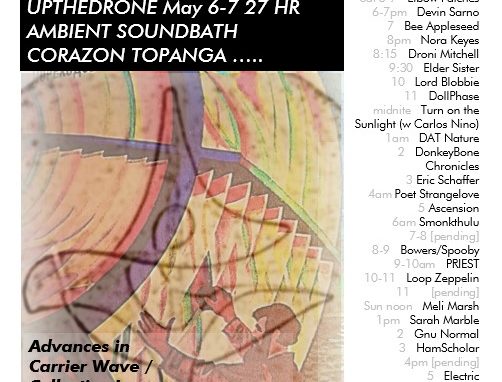A recent article at EOS revealed that seismologists & geophysicists have been aware for decades of “continent-sized blobs” deep in the Earth.
By “blob” they mean an area of discontinuity, where seismic waves travel more slowly. But, the researchers are not clear if that means the “blob” is more, or less, dense, than the surrounding mantle. There are conflicting studies and methods.
“They’re among the largest things inside the Earth,” University of Maryland geologist Ved Lekic told Eos reporter Jenessa Duncombe, “and yet we literally don’t know what they are, where they came from, how long they’ve been around, or what they do.”
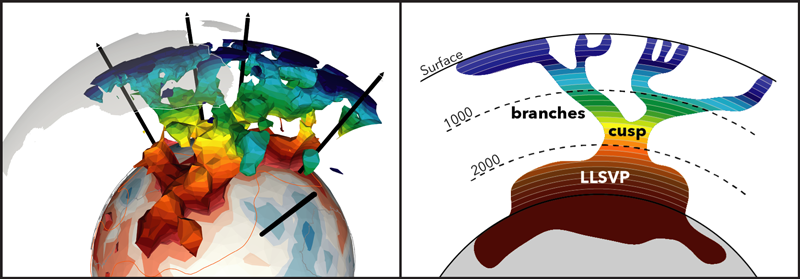
Part of the reason for this mystery is what Earth scientists have always struggled with: They will never be able to visit the inside of Earth. “We know less about what’s deep below our feet than the surface of the Sun or the Moon or Mars,” … Scientists are constantly trying to come up with new ways to peek inside Earth indirectly.
In fact, the deepest anyone has ever drilled into the Earth is about 10 kilometers – the Kola Borehole in Russia. That 10 km is an almost invisible pinprick in relation to the approx 3600 miles down to the center of the Earth. All other data is essentially indirect – extrapolations from seismic waves, from the magnetic field, gravity readings from satellites… neutrinos…?
One of the striking things about the EOS “blob” story is the fact that researchers seem to have been aware of this phenomenon for 4 decades. Yet for all the coverage that S and P waves have gotten in the popular media (!?), this is the first time I can remember hearing about “the blob”. Maybe that is simply my own ignorance.
Two other things most people may not be aware of:
OCEANS may exist inside the crust (or really large volumes of water, at any rate, maybe not as discrete bodies of water, but interspersed in the rocky materials).
The Earth is not gravitationally smooth – there are bumps and shallows.
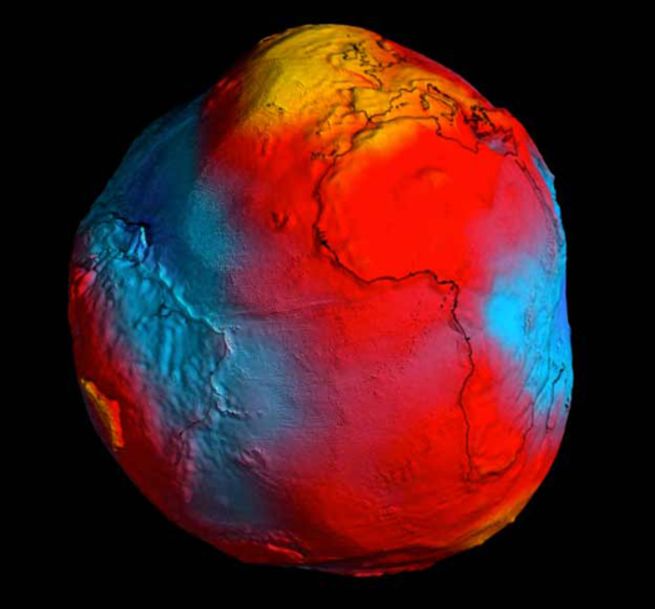
In any case, folks who frequent fringe literature will no doubt have perked up at this mention of “continent sized mystery blobs” deep inside the Earth. As there exists a rather large mythology around the notion of the “Hollow Earth.”
The most well-known and extreme versions of Hollow Earth posited that our planet is in fact shaped like a kind of donut, with large openings at the north and south poles, leading to a populated inner world and a “Central Sun.” Dozens of books were written from the 1820s through the 1930s riffing on this mind-boggling possibility (many of them, incidentally, associated with Theosophy and the occult). In the 1820’s there was a strong push for Congress to back an expedition to investigate the “Symmes Holes” (after the author of one book on the topic). (In its place, the National Geographic Society was founded. “Hmm” might be a valid response, as the Kookie Conspiracy Theorist arches his/her eyebrow and puffs on the Sherlock Holmes pipe.)

Also, according to Ray Palmer, the (in)famous editor of Amazing Science Fiction magazine, UFOs probably come from inside the Hollow Earth (thank Richard Shaver for that insight). Even into the 70s, Palmer continued to push Hollow Earth ideas, pointing out that so-called polar-orbiting satellites don’t actually fly directly over the poles. Why not? It’s hard to find a clear explanation in publicly available documents. Magnetic issues – it’s a fact (yes, an actual fact!) that compasses start spinning as you close into the poles.

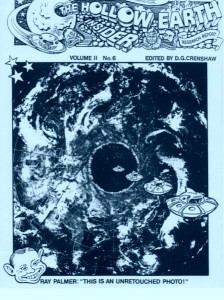
Since the teens of the last century, the full Hollow Earth model has drifted into the misty outer isles of sci fi, channelling & ‘general kookery,’ as David Pratt highlights:
Many explorers have now walked or sledged to the poles, flown over them, satellites have photographed them, and since 1956 there has been a permanently manned base at the south pole. A number of expeditions have crossed directly across the north and south poles, and some have approached each other from different parts of Antarctica and met at the correct spot. But no polar openings have apparently been discovered. At least, none are marked on maps. This is seen by many hollow-earthers as evidence of a vast international conspiracy.6 —David Pratt , Mysteries of the Inner Earth
Still, the Hollow Earth crazies won’t give up.
About a decade ago, Hollow Planets: A Feasibility Study of Hollow Worlds, by a South African programmer Jan Lamprecht, claimed to advance the thinking on the subject, in a somewhat more science-y direction. Lamprecht kicks off by inventorying data to the effect that all planets and moons are also hollow. (One standard critique of H.E. is that the Earth can’t possibly be hollow because it would throw off the gravitational dynamics of the solar system. But if all planets are hollow, not such a problem.) Lamprecht was writing well before images of the enormous vortices at the poles of Saturn and Jupiter were returned by the Juno mission.
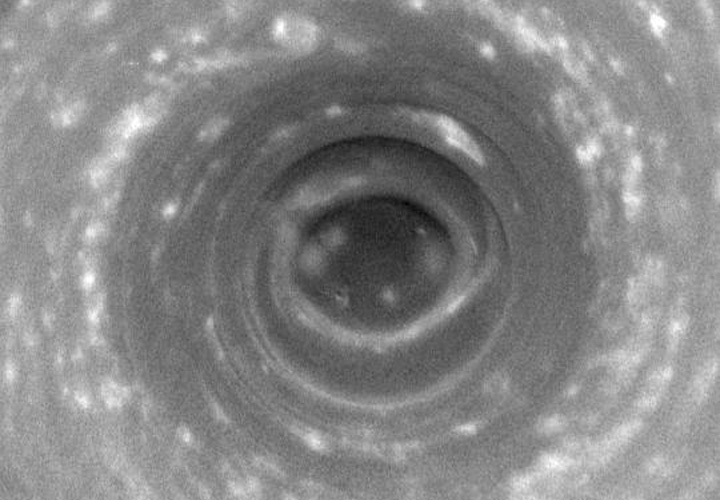

Of course, Saturn and Jupiter are gas giants, and the composition of their inner cores is unknown, assuming they even have such things. So their vast polar vortices could hardly apply to solid planets….
Oh, but wait – it appears that Venus ALSO has similar polar vortexes – or maybe funnels would be a better term, as seen below! Venus is a solid planet not a gas giant. Of course, these are just features of “storms” and (presumably?) don’t they reach into and below the actual surface of Venus. But the only probe to land on the surface of the Venus died almost immediately, and it wasn’t at the poles. (Yeah, we Earthlings have our own polar vortex, we know that jet stream circles around the poles North and South. We have our own North and South auroras, which are products of the magnetic field responding to incoming cosmic particles. In the 19th century the Hollow Earth writers attributed the auroras to light escaping from the inner Central Sun through the holes.)

So, while we’re hanging out in the astrophysics zone, let’s watch a clip from the ISS of some fun tricks with globs of water in zero-G (well, near Zero-G). Heavier materials migrate to the OUTSIDE of the globule. It’s also what you might expect from the centrifugal force from a rotating body in space. One could reasonably ask, wouldn’t this same principle apply at planetary scale:
Coming back to Lamprecht, he goes into some detail on seismic readings, and what they seem to tell us about the inner structure of the Earth. (“Blobs” not mentioned.)

Lamprecht holds that the data is corrupted by assumptions, leading to a false picture. Here is a summary of Lamprecht’s argument by the sympathetic but skeptical David Pratt.
More recently, folks from the Electric Universe / Plasma Cosmology crowd have also started to hack away at the mainstream default model that the Earth’s magnetic field is derived from flowing nickel-iron in the core — the academic geophysicists’ Best Guess. As mentioned above, some speculate that there is a large amount of water flow in the Earth’s crust or mantle. But this speculative alternative has not been seriously worked out in a paper, just alluded to in online videos from the Thunderbolts Project.
Another heretical gloss proposes that the Earth is hollow-ish, filled not with liquid metals but… STEAM. This model ties into the Expanding Earth Hypothesis. In fact, it is proposed as the very mechanism that academic Expanding Earth theorists lacked back in the 50s (yes, a tad shocking, but the Expanding Earth was a legitimate topic for decades). (Further note – James Maxlow seems to be the current figurehead for Expanding Earth Theory, if you set aside Neal Adam’s popular YT animations) Popular Mechanics summarizes Expanding Earth here, if rather derisively.
Lastly, the preferred modern variant of Hollow Earth in the alt.UFO.conspira-theory circuit is the “Honeycomb” model. No mo’ big ol’ Holes at da Poles, no completely hollow interior, no “Central Sun.” Just a subterranean realm pocketed by vast networks of caverns inhabited by marvelous entities and things — reptilians, ETs, lost and advanced human civilizations, refugees from surface apocalypses, NAZIS!, 50 foot tall goddesses (presumably HOT) (Shaver), & pretty much anything else you want to imagine that’s really really cool but kind of hard to justify in the daylight consensus reality.
Moral of the story. Before we totally write off all these “crank theories”, let’s be humble. Good, real science acknowledges upfront what it doesn’t know, what is based on speculation and inference, versus hypotheses derived from direct, verifiable data.
Let’s remind ourselves again:
“We know less about what’s deep below our feet than the surface of the Sun or the Moon or Mars.”
Update 6/25/2020: New research expands on inner structures


